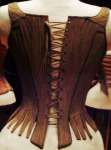There are stays that lace at the back (Diderot calls them corps fermé, closed stays) and those that lace across a stiff stomacher in front (corps ouvert, or open stays). Examples that lace both back and front (but not over a stomacher) are quite rare. Stays that lace in front only are even rarer and so far only known to me from the region of Southern Germany. In all these cases, spiral lacing is used.
Although 18th century stays were not meant to be seen, they are often quite decorative, with finely stitched tunnels for the boning, precious silk brocade and possibly gold trim. The inside, on the other hand, usually looks downright sloppy, even in outwardly fine stays.
The basic shape of stays didn't change the whole century long. Towards the end, around 1790, when dress waists begin to wander upwards, the stays become slightly shorter. Since paniers were not worn anymore, the skirt is supported by small pads sewn to the tabs. At the same time, physicians make themselves heard, warning against the harm done by tight-lacing. While lacing wasn't usually overdone as much as one century later, it often started earlier: It started with tightly wrapping babies and included children's corsets, forcing the still soft skeleton into a fashionable shape.

i tried to wear it once but i couldn't handle it..
ReplyDelete